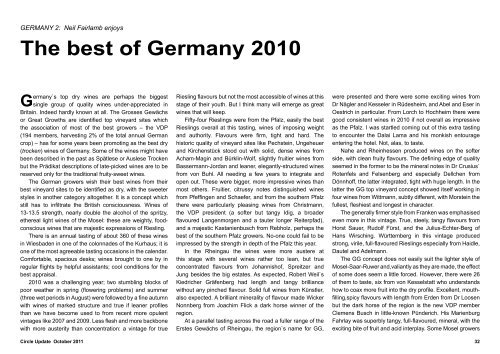You also want an ePaper? Increase the reach of your titles
YUMPU automatically turns print PDFs into web optimized ePapers that Google loves.
GERMANY 2: Neil Fairlamb enjoysThe best of Germany 2010Germany`s top dry wines are perhaps the biggestsingle group of quality wines under-appreciated inBritain. Indeed hardly known at all. The Grosses Gewächsor Great Growths are identified top vineyard sites whichthe association of most of the best growers – the VDP(194 members, harvesting 2% of the total annual Germancrop) – has for some years been promoting as the best dry(trocken) wines of Germany. Some of the wines might havebeen described in the past as Spätlese or Auslese Trockenbut the Prädikat descriptions of late-picked wines are to bereserved only for the traditional fruity-sweet wines.The German growers wish their best wines from theirbest vineyard sites to be identified as dry, with the sweeterstyles in another category altogether. It is a concept whichstill has to infiltrate the British consciousness. Wines of13-13.5 strength, nearly double the alcohol of the spritzy,ethereal light wines of the Mosel: these are weighty, foodconsciouswines that are majestic expressions of Riesling.There is an annual tasting of about 360 of these winesin Wiesbaden in one of the colonnades of the Kurhaus; it isone of the most agreeable tasting occasions in the calendar.Comfortable, spacious desks; wines brought to one by inregular flights by helpful assistants; cool conditions for thebest appraisal.2010 was a challenging year; two stumbling blocks ofpoor weather in spring (flowering problems) and summer(three wet periods in August) were followed by a fine autumnwith wines of marked structure and true if leaner profilesthan we have become used to from recent more opulentvintages like 2007 and 2009. Less flesh and more backbonewith more austerity than concentration: a vintage for trueRiesling flavours but not the most accessible of wines at thisstage of their youth. But I think many will emerge as greatwines that will keep.Fifty-four Rieslings were from the Pfalz, easily the bestRieslings overall at this tasting, wines of imposing weightand authority. Flavours were firm, tight and hard. Thehistoric quality of vineyard sites like Pechstein, Ungeheuerand Kirchenstück stood out with solid, dense wines fromAcham-Magin and Bürklin-Wolf, slightly fruitier wines fromBassermann-Jordan and leaner, elegantly-structured winesfrom von Buhl. All needing a few years to integrate andopen out. These were bigger, more impressive wines thanmost others. Fruitier, citrussy notes distinguished winesfrom Pfeffingen and Schaefer, and from the southern Pfalzthere were particularly pleasing wines from Christmann,the VDP president (a softer but tangy Idig, a broaderflavoured Langenmorgen and a tauter longer Reiterpfad),and a majestic Kastanienbusch from Rebholz, perhaps thebest of the southern Pfalz growers. No-one could fail to beimpressed by the strength in depth of the Pfalz this year.In the Rheingau the wines were more austere atthis stage with several wines rather too lean, but trueconcentrated flavours from Johannishof, Spreitzer andJung besides the big estates. As expected, Robert Weil`sKiedricher Gräfenberg had length and tangy brilliancewithout any pinched flavour. Solid full wines from Künstler,also expected. A brilliant minerality of flavour made WickerNonnberg from Joachim Flick a dark horse winner of theregion.At a parallel tasting across the road a fuller range of theErstes Gewächs of Rheingau, the region`s name for GG,were presented and there were some exciting wines fromDr Nägler and Kesseler in Rüdesheim, and Abel and Eser inOestrich in particular. From Lorch to Hochheim there weregood consistent wines in 2010 if not overall as impressiveas the Pfalz. I was startled coming out of this extra tastingto encounter the Dalai Lama and his monkish entourageentering the hotel. Not, alas, to taste.Nahe and Rheinhessen produced wines on the softerside, with clean fruity flavours. The defining edge of qualityseemed in the former to be the mineral notes in Dr Crusius`Rotenfels and Felsenberg and especially Dellchen fromDönnhoff, the latter integrated, tight with huge length. In thelatter the GG top vineyard concept showed itself working infour wines from Wittmann, subtly different, with Morstein thefullest, fleshiest and longest in character.The generally firmer style from Franken was emphasisedeven more in this vintage. True, steely, tangy flavours fromHorst Sauer, Rudolf Fürst, and the Julius-Echter-Berg ofHans Wirsching. Württemberg in this vintage producedstrong, virile, full-flavoured Rieslings especially from Haidle,Dautel and Adelmann.The GG concept does not easily suit the lighter style ofMosel-Saar-Ruwer and,valiantly as they are made, the effectof some does seem a little forced. However, there were 26of them to taste, six from von Kesselstatt who understandshow to coax more fruit into the dry profile. Excellent, mouthfilling,spicyflavours with length from Erden from Dr Loosenbut the dark horse of the region is the new VDP memberClemens Busch in little-known Pünderich. His MarienburgFahrlay was superbly tangy, full-flavoured, mineral, with theexciting bite of fruit and acid interplay. Some Mosel growers<strong>Circle</strong> <strong>Update</strong> October 2011 32


